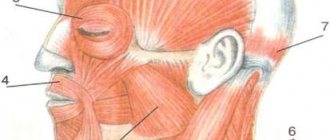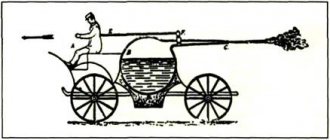Methods for solving problems in the mechanics of oscillatory motion
Lesson summary
in PHYSICS
in 11th grade
on this topic
“Methods for solving problems in the mechanics of oscillatory motion.”
Methods for solving problems in the mechanics of oscillatory motion
Grade 11. Basic course.
The purpose of the lesson: - to help students understand the practical and personal significance of this educational material;
— to help those who disappear to realize the value of joint activities;
— to promote the development in students of the ability to highlight the main thing in defining the concepts of oscillatory movements;
— create conditions for the development of eleventh-graders’ skills in formulating a problem and proposing ways to solve it;
- promote the development of children's communication skills.
Today our lesson is being held as a creative workshop. You will have to work in groups. There are five groups in total. Take stencils with group numbers and attach them to your place. Choose the square with the color that best suits your mood for today's lesson.
Listen to some tips:
Trust your hand when you write.
Try not to suppress your thoughts.
Try to listen to what your neighbor is saying, especially when discussing in a group.
Try to be kind to each other.
The epigraph of our work will be the German proverb: “Hans does not know what Hansik has not learned.”
If you read something, then learn the main idea from what you read. This is what I do: from what I read, I will certainly note something.
Seneca
Take sheet number 1 and, using the word hesitation, make up as many words as possible in half a minute. Everyone works on their own. After 30 seconds, write down all the words received in the group. Now report to the whole class what happened.
This is a little warm-up. Now let's review the material we covered.
We work orally, i.e. the main thing is to solve without formalizing the decision. Take sheet No. 2 and in three minutes write the answers to the problems:
- The body made 60 oscillations in 15 s. What are the period and frequency of oscillations?
- What is the frequency of oscillation and the cyclic frequency of oscillation if the period is 5 s?
- The oscillatory motion is given by the equation x = 0.2cos 4πt. What is the amplitude of the vibrations?
- How will the period of oscillation of a spring pendulum change when the body mass increases by 4 times?
- How many times must the period of oscillation of a thread pendulum be changed in order for its length to change by 9 times?
Answers:
- 2.5 s; 4 Hz.
- 0.2 Hz; 0.4π rad/s.
- 0.2 m.
- Will increase 2 times.
- Increase by 3 times.
Pass your piece of paper to your neighbor on the right in circle 1→2; 2→3; 3→4; 4→5; 5→1.
Check solutions, find errors. Discuss the results in groups and give each person marks.
The third numbers from each group do an error analysis.
Give the results to your teacher.
Please remember the features of oscillatory motion and its main characteristics. How do you determine whether a given vibration is harmonic?
Receive task cards, sign sheet No. 3 and solve the first problem yourself. Discuss this decision in the group. The fourth number from each group reports what happened.
Complete the second and third tasks. Take only the numbers from each answer, find their sum, write it down on a piece of paper and give it to the teacher.
The fifth number checks the calculation results.
Task 2.
Task 1.
Find the amplitude, period and frequency of oscillations if the law of oscillations of a point has the form x = 5cos 6.28t (cm). Answer: 0.05 m; 1 s; 1 Hz.
Task 2.
Determine the period of oscillation of a load weighing 0.1 kg suspended from a spring with a stiffness coefficient of 10 N/m. Answer: 0.63 s.
Task 3.
Determine the mass of a load that, on a spring with a stiffness of 250 N/m, makes 20 oscillations in 16 s. Answer: 4.05 kg.
Task 4.
A mass of 2 kg is suspended on a spring and oscillates, the graph of which is shown in the figure. What is the spring stiffness? Answer: 79 N/m.
Task 5.
How are the lengths of the pendulums related if during the same time one made 10 and the other 30 oscillations? Answer: 9.80 m/s².
Task 6.
One mathematical pendulum has a period of 3 s, and the other has a period of 4 s. What is the period of oscillation of a pendulum whose length is equal to the sum of the lengths of these pendulums? Answer: 5 s.
Task 7.
A bee's wings vibrate at a frequency of 240 Hz. How many wing flaps will a bee make while flying to a flower field located 500 m away if it flies at a speed of 4 m/s? Answer: 30000.
Find the sum of all the numbers obtained in the answers to the seven problems. Answer: 30100.53
We have five students behind. Please summarize your work.
We solve problems for the selection of each group. The number of the problem to be solved is determined by the group council or the senior in the group. Receive envelopes with assignments.
Exercise 1.
In 1 s, a mosquito makes 600 wing beats, and the period of oscillation of a bumblebee’s wings is 5 ms. Which insect flaps its wings more in 1 minute and by how much more? Answer: A mosquito makes 24,000 more flaps.
Task 2.
A material point performs harmonic oscillations with an initial phase of π/2 rad, a frequency of 2 Hz and an amplitude of 3 cm. Write down the law of oscillation of the point and construct a graph of the displacement versus time if the oscillations occur according to the sine law. Answer: x = 3sin(4πt + π/2).
Task 3.
Calculate the amplitude of the oscillations if for phase π/6 rad the displacement is 6 cm. The oscillations occur according to the sine law. Answer: 12 cm.
Task 4.
The period of oscillation of the body on the spring is 0.5 s. How much will the length of the spring decrease if the load is removed from it? Answer: 6.2 cm.
Task 5.
Two mathematical pendulums begin to oscillate simultaneously. When the first pendulum completed 20 complete oscillations, the second completed only 10 oscillations. What is the length of the first pendulum if the length of the second is 4 m? Answer: 1 m.
We check our decisions. Everyone who solved the first problems gather at table No. 1, the second - at table No. 2, etc. discuss solutions, analyze errors and choose someone who is able to defend your solution at the board.
We defend the presented solutions at the board. Group representatives can help a friend if the need arises.
Summarizing.
-I would like you not to end up in the role of Hans. Explain to me the meaning of this proverb.
What should be the methods for solving problems involving oscillatory motion?
Complete the phrases:
Today in class I learned _________, learned ___________.
What I remember most is _____________.
I was interested in the task _______________.
How did the lesson make you feel?
Now choose a square of the color that matches your mood?
Thank you for the lesson, you all worked hard and I am pleased that in this lesson you learned to solve problems and look for ways to solve them.
5
Download material
so UNT / Lesson developments / Physics lessons
Physics 9th grade. Topic: Oscillatory motion. Basic quantities characterizing oscillatory motion. (Amplitude, period, frequency.).
02.10.2014 7354 1402
"Equation of oscillatory motion."
Objectives: to introduce students to the quantities characterizing oscillatory motion, to find out what the period of oscillation depends on; develop the ability to apply knowledge in practice, include it in solving educational problem situations, develop logical thinking; to cultivate cognitive interest, activity, interest in learning new educational material. Lesson type:
learning new material.
During the classes
I. Organizational moment
II. Updating knowledge
III. Explanation of a new topic
Oscillatory motion
You have probably seen oscillatory movements at least once in your life in a swinging pendulum of a clock or tree branches in the wind. Chances are you've at least once pulled the strings of a guitar and seen them vibrate. Obviously, even if you haven’t seen it with your own eyes, you can at least imagine how a needle moves in a sewing machine or a piston in an engine.
Oscillations or oscillatory movements
In all of the above cases, we have a body that periodically performs repeating movements. It is precisely such movements that are called oscillations or oscillatory movements in physics. Fluctuations occur in our lives very, very often.
They can be very diverse, but they are united by one common main characteristic: periodically repeating movements. These movements are repeated at regular intervals, called the oscillation period.
In the motion of an oscillating body, three points are distinguished: the equilibrium position and two extreme points.
The equilibrium position is the point at which a body would be if it were at rest. During oscillation, the body periodically passes through an equilibrium position.
And the extreme points are the magnitude of the maximum deviation from the equilibrium position. The distance from the equilibrium position to the extreme points is called the amplitude of oscillations.
Free vibrations
In the process of oscillations, the body constantly strives for an equilibrium position. Vibrations arise due to the fact that someone or something has deflected a given body from its equilibrium position, thus giving the body energy, which causes its further vibrations.
Vibrations that occur only as a result of this initial energy are called free vibrations. This means that they do not require constant assistance to maintain the oscillating motion.
Most fluctuations in the reality of life occur with gradual attenuation, due to friction forces, air resistance, and so on. Therefore, free oscillations are often called such oscillations, the gradual attenuation of which can be neglected during observations.
Oscillatory systems: pendulum
In this case, all bodies connected and directly involved in vibrations are collectively called an oscillatory system.
In particular, if a freely suspended body oscillates on a thread, then the oscillatory system will include the body itself, the suspension, what the suspension is attached to, and the Earth with its attraction, which causes the body to oscillate, constantly returning it to a state of rest.
Such a body is a pendulum. In physics, there are several types of pendulums: thread, spring and some others. All systems in which an oscillating body or its suspension can be conventionally represented as a thread are thread systems.
Well, spring pendulums, as you might guess, consist of a body and a certain spring, which causes vibrations.
See the downloadable file for the full text of the material.
The page contains only a fragment of the material.





